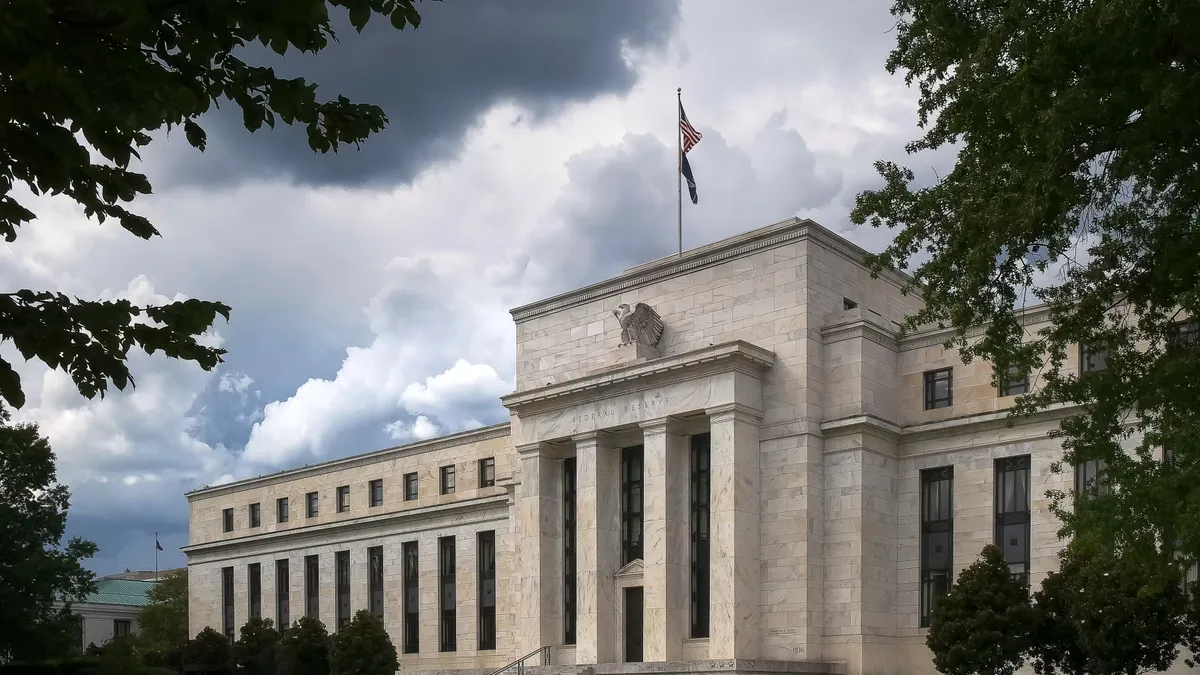Dive Brief:
- Federal Reserve officials, before a unanimous vote to raise the main interest rate this month to a 16-year high, disagreed on the need to hike again at a scheduled two-day meeting ending June 14, according to minutes of their May 2-3 gathering.
- “Several participants noted that if the economy evolved along the lines of their current outlooks, then further policy firming after this meeting may not be necessary,” according to the minutes released Wednesday. Other meeting participants said further rate hikes may be warranted because they expected “progress returning inflation to 2% could continue to be unacceptably slow.”
- Fed economists forecast at the meeting that a pullback in bank credit and higher interest rates will trigger a “mild recession” in the fourth quarter of this year into the first quarter of 2023 “followed by a moderately paced recovery,” according to the minutes.
Dive Insight:
Financial markets currently signal expectations that the central bank will begin cutting the federal funds rate as early as September, despite comments to the contrary in recent weeks from Fed Chair Jerome Powell and other policymakers.
Traders in interest rate futures markets on Wednesday set 71% odds that the Fed will pause and hold the federal funds rate at a range between 5% to 5.25% next month after steadily raising it from near zero at consecutive meetings since March 2022, according to the CME FedWatch Tool. They see only a 27% probability that the main rate will be at its current level or higher at the end of this year.
Since the Fed raised the main interest rate on May 3, central bank officials have voiced a range of opinions about whether policymakers should continue tightening or pause hikes at their meeting next month.
“I think right now it’s a close call either way, versus raising another time in June or skipping” an increase in the main rate, Minneapolis Fed President Neel Kashkari said Monday in an interview on CNBC. “What’s important to me is not signaling that we’re done” with tightening monetary policy at the June meeting.
St. Louis Fed President James Bullard took a firmer stance, saying that the central bank should increase borrowing costs two more times in 2023.
“I think we’re going to have to grind higher with the policy rate in order to put enough downward pressure on inflation to return inflation to target in a timely manner,” Bullard said Monday.
The Fed seeks to hold inflation to 2%, which is less than half the current rate.
Despite the most aggressive Fed tightening in four decades, price pressures have not eased quickly enough and financial markets in recent weeks indicate that investors expect inflation to end the year higher than they previously forecast, Bullard said.
“I’m thinking two more moves this year,” he said. “Exactly where those would be this year I don’t know, but I’ve often advocated sooner rather than later.”
Although the Fed’s inflation fight has so far not achieved its objectives, a pullback in credit triggered by recent stress in the banking system may slow economic growth and override the need for more rate hikes, Fed Governor Christopher Waller said Wednesday.
“One might view the current incoming data as supporting a hike in June, but I believe that caution is warranted because there is a high level of uncertainty about how credit conditions are evolving,” Waller said.
“Another hike combined with an abrupt and unexpected tightening of credit conditions may push the economy down in a rapid and undesirable manner,” he said.
At the same time, “fighting inflation continues to be my priority,” Waller said. “I do not support stopping rate hikes unless we get clear evidence that inflation is moving down toward our 2% objective.”
Powell during a webcast Friday voiced openness to pausing the central bank’s most aggressive withdrawal of accommodation in four decades.
“As policy has become more restrictive, the risk of doing too much versus doing too little are becoming more balanced,” he said.
“We’ve come a long way in policy tightening and the stance of policy is restrictive, and we face uncertainty about the lagged effects of our tightening so far, and about the extent of credit tightening from recent banking stresses,” Powell said in an interview.
“Our guidance is limited to identifying the factors we'll be monitoring as we assess the extent to which additional policy firming may be appropriate to return inflation to 2%,” Powell said, reading a statement.
Powell and other policymakers, including New York Fed President John Williams, have recently said they do not expect to trim borrowing costs this year.












